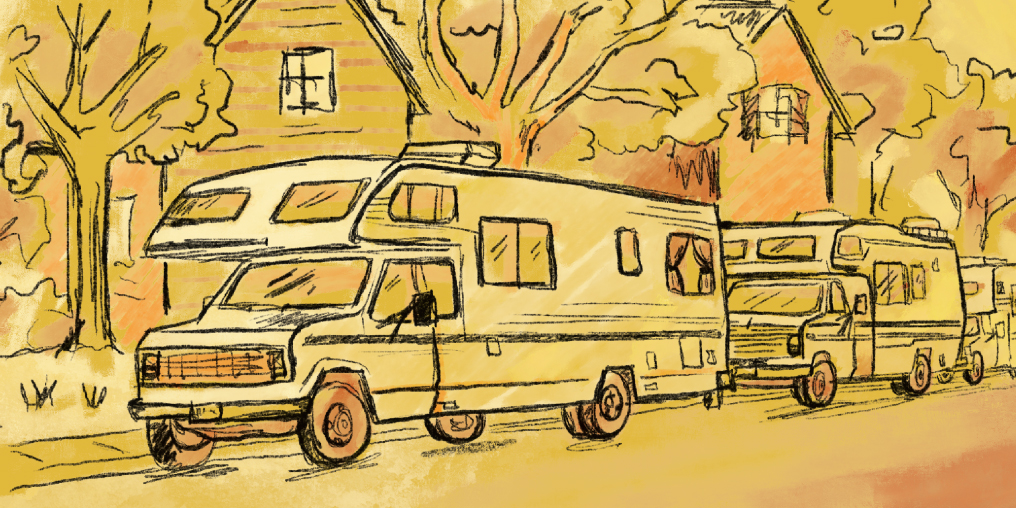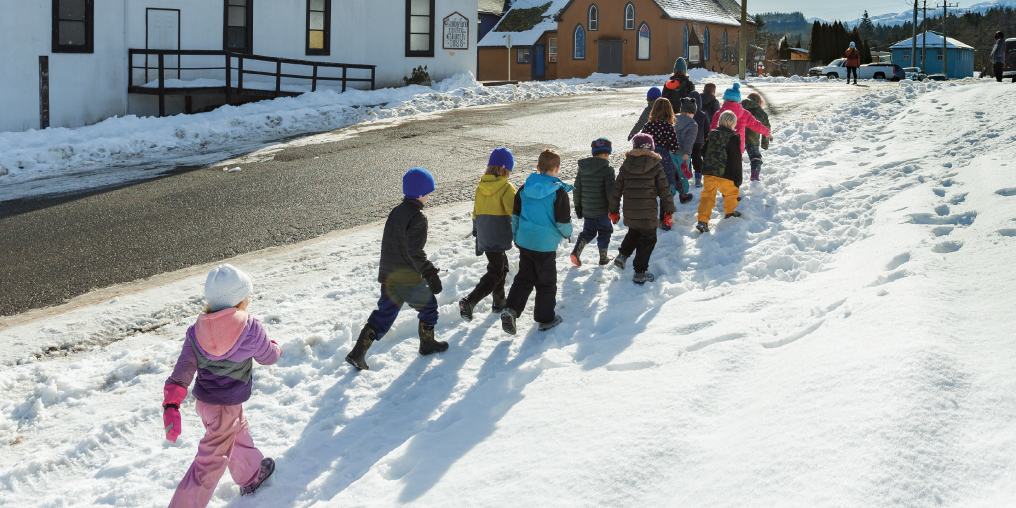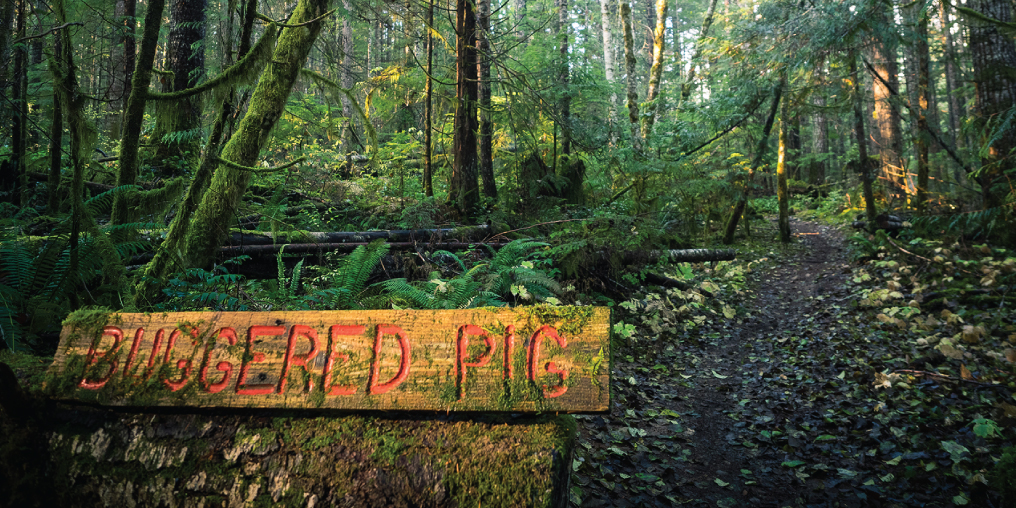Imagine two scenarios. The first is a quiet suburb of single-family homes—the Canadian dream—but with vans, campers, fifth wheels, and other RVs parked in your neighbours’ driveways and operating like year-round, long-term, rental suites.
The second is a flashback to the depths of the pandemic, when restaurants and cafés were reduced to pick-up windows. But in this scenario, it’s because rent is so expensive the businesses can’t find staff who can afford to live in the Comox Valley.
Darren Adam believes we’re at a crossroads between these two scenarios. The owner of the Cumberland Brewing Company says already his staff are struggling to afford housing. If the costs continue rising on their present trajectory, he thinks within a few years they won’t be able to live in the Comox Valley at all. In August he wrote to Cumberland council urging them to consider legalizing long-term RV living as a quick and affordable solution to the housing crisis.
“This plan may not be the best one,” Adam admits. “My goal with the letter was to be an agitator. To say, “Let’s be brave and think outside of the box.’”
Everyone agrees affordability is a huge issue and one that’s far too complex and nuanced to cover in this entire magazine, let alone this one article. Federal, provincial, and municipal governments are all working on programs and projects that should help, including building non-market housing with controlled rents, streamlining permitting to encourage denser neighbourhoods, incentivizing the construction of rental apartments, and reducing the number of short-term rentals like Airbnb and VRBO. But it will take years for those changes to impact housing affordability. In the meantime, there is an urgent need for shorter term solutions.
The 2023 “Point-In-Time” homeless count showed that the number of people in the Comox Valley without a stable roof over their head doubled in three years; more than 50 per cent of those surveyed said the cost of housing was a contributing factor to their lack of shelter. Local rental vacancy rates are below one per cent. The average sale price of a single-family home in the Comox Valley increased in the last decade from $338,700 to $889,663 in 2022. And people keep moving here. Courtenay’s official community plan projects population growth of 4,500 people, or 2,900 housing units, within 10 years.
So far, the strategy has been to make it easier for people to install secondary suites and build carriage houses, also known as accessory dwelling units (ADUs). The British Columbia government has announced plans to allow densifying every single-family lot in the province without rezoning; Courtenay’s council recently amended its rules to encourage the creation of more rental suites. Since a similar rule change came into effect in Cumberland in 2017, homeowners have added 57 secondary suites and carriage houses.
“Council has done good work to increase density with ADUs,” says Adam. “But the cost of building has doubled and tripled. It’s now untenable to build something like that and get a return on your money.”
RVs and tiny homes on trailers are comparatively cheap and instant. But they don’t adhere to provincial building codes, and most jurisdictions limit their use to 30 to 90 days. A few resort towns, including Canmore, Ucluelet, and Tofino, have created seasonal solutions to help house an influx of summer staff, but so far none of these ideas has lasted.
Valemount is one of the few jurisdictions that has experimented with legalizing year-round living. The town of 1,052 people is in east central BC, near the Alberta border. Over the last three years the population tripled as more than 2,000 people arrived to work on the Trans Mountain Pipeline expansion. Rents shot up to $5,000 a month for a mobile home.
“We had an extreme housing shortage,” says Owen Torgerson, the mayor. “We saw a massive increase in the number of people living in RVs, some of them in the bush with nothing. We figured we better start regulating it before it really got out of hand.”
Valemount’s council created a temporary use permit to allow homeowners to rent their driveways to RV owners. The cost of the permit covered administrative costs and an inspection to ensure safe water and power hookups and regular septic pumping. The Village has issued 18 permits, which increased the housing stock by three per cent, says the mayor. More workers rented RV space on rural lots in the nearby regional district. Even with the pipeline construction winding down and rents falling, this year the council voted to extend the program for another three years.
“I think it was a good way to deal with an acute housing crunch,” says the mayor.
Neil Borecky says that’s exactly why it won’t work in Cumberland.
“Trans Mountain Pipeline created an acute pulse with a start and end,” says the Village councillor. “What we have is different. If we foster longer-term RV living, we are going to have problems.”
There are safety concerns with RV living in general, particularly an increased fire hazard and the potential for mold. And when RVs are parked in residential neighbourhoods, they can clog access and exits. Borecky also worries that managing the permitting and inspections will increase workload on a Village staff already stretched thin. Plus, adding density without a tax base puts more pressure on services, like schools, garbage pickup, and policing, without the increased revenue to pay for them. These are similar concerns to the ones planners raised in Campbell River in 2021, when its council turned down adding RVs to a mobile home park.
But Borecky does think RV living could work on bigger, more rural-feeling lots in the village and he’s all for other creative ideas like tiny home villages, which could include several small dwellings, rather than one or two big houses.
Another potential quick fix is to put more people in the houses that already exist.
“There’s a high number of people who are considered over-housed,” says Rebekah Parker, from Simon Fraser University’s Housing Solutions Lab.
The lab has identified 13,000 houses on Vancouver’s North Shore where homeowners live alone or with one other person and have more space than they need. The lab’s researchers are now working on strategies to encourage the owners to add a secondary suite or take part in home sharing, where a tenant rents a room in the house.
Cost is the biggest hurdle to adding a suite; the provincial government recently announced a grant program that will help. The lab is working on resources to address the other major challenge: overcoming homeowner concerns about becoming a landlord, like picking the right tenant and dispute resolution.
“One reason we’re really excited about the possibility of home sharing, in particular, is because it can address a lot of compounding crises, like affordability, social isolation, and climate change,” Parker says. “There’s an appetite for ideas like this and a lot of these ideas are not new. Boarding houses and boarders used to be pretty common.”
The same can be said about RVs. People have been living in them at Courtenay’s Maple Pool Campground and RV Park for at least 20 years. Between 2011 and 2015, Dawn to Dawn Action on Homeless Society and the Comox Rotary Club placed several donated, refurbished RVs to house the homeless there. More recently, WeCan Shelter Society has donated shipping containers converted into tiny homes.
Neither the shipping containers nor the RVs meet building codes, but the City has not taken steps to regulate them. As Courtenay councillor Melanie McCollum points out, “It’s a lot better than living in a tent. RVs are not ideal, but are we going to put a stop to it when we don’t have a better solution?”





